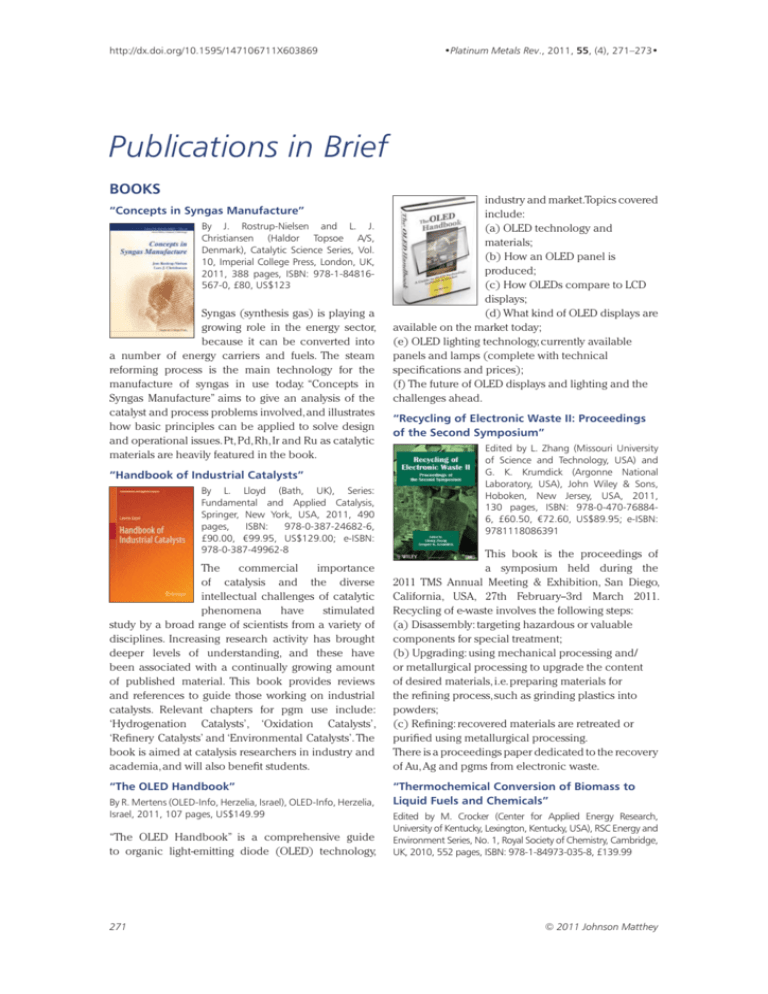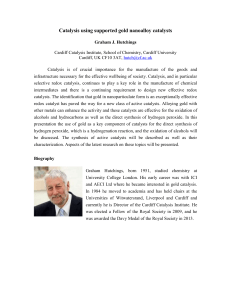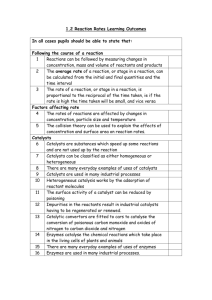this article - Johnson Matthey Technology Review
advertisement

http://dx.doi.org/10.1595/147106711X603869 •Platinum Metals Rev., 2011, 55, (4), 271–273• Publications in Brief BOOKS “Concepts in Syngas Manufacture” By J. Rostrup-Nielsen and L. J. Christiansen (Haldor Topsoe A/S, Denmark), Catalytic Science Series, Vol. 10, Imperial College Press, London, UK, 2011, 388 pages, ISBN: 978-1-84816567-0, £80, US$123 Syngas (synthesis gas) is playing a growing role in the energy sector, because it can be converted into a number of energy carriers and fuels. The steam reforming process is the main technology for the manufacture of syngas in use today. “Concepts in Syngas Manufacture” aims to give an analysis of the catalyst and process problems involved, and illustrates how basic principles can be applied to solve design and operational issues. Pt, Pd, Rh, Ir and Ru as catalytic materials are heavily featured in the book. “Handbook of Industrial Catalysts” By L. Lloyd (Bath, UK), Series: Fundamental and Applied Catalysis, Springer, New York, USA, 2011, 490 pages, ISBN: 978-0-387-24682-6, £90.00, €99.95, US$129.00; e-ISBN: 978-0-387-49962-8 The commercial importance of catalysis and the diverse intellectual challenges of catalytic phenomena have stimulated study by a broad range of scientists from a variety of disciplines. Increasing research activity has brought deeper levels of understanding, and these have been associated with a continually growing amount of published material. This book provides reviews and references to guide those working on industrial catalysts. Relevant chapters for pgm use include: ‘Hydrogenation Catalysts’, ‘Oxidation Catalysts’, ‘Refinery Catalysts’ and ‘Environmental Catalysts’. The book is aimed at catalysis researchers in industry and academia, and will also benefit students. “The OLED Handbook” By R. Mertens (OLED-Info, Herzelia, Israel), OLED-Info, Herzelia, Israel, 2011, 107 pages, US$149.99 “The OLED Handbook” is a comprehensive guide to organic light-emitting diode (OLED) technology, 271 industry and market.Topics covered include: (a) OLED technology and materials; (b) How an OLED panel is produced; (c) How OLEDs compare to LCD displays; (d) What kind of OLED displays are available on the market today; (e) OLED lighting technology, currently available panels and lamps (complete with technical specifications and prices); (f) The future of OLED displays and lighting and the challenges ahead. “Recycling of Electronic Waste II: Proceedings of the Second Symposium” Edited by L. Zhang (Missouri University of Science and Technology, USA) and G. K. Krumdick (Argonne National Laboratory, USA), John Wiley & Sons, Hoboken, New Jersey, USA, 2011, 130 pages, ISBN: 978-0-470-768846, £60.50, €72.60, US$89.95; e-ISBN: 9781118086391 This book is the proceedings of a symposium held during the 2011 TMS Annual Meeting & Exhibition, San Diego, California, USA, 27th February--3rd March 2011. Recycling of e-waste involves the following steps: (a) Disassembly: targeting hazardous or valuable components for special treatment; (b) Upgrading: using mechanical processing and/ or metallurgical processing to upgrade the content of desired materials, i.e. preparing materials for the refining process, such as grinding plastics into powders; (c) Refining: recovered materials are retreated or purified using metallurgical processing. There is a proceedings paper dedicated to the recovery of Au, Ag and pgms from electronic waste. “Thermochemical Conversion of Biomass to Liquid Fuels and Chemicals” Edited by M. Crocker (Center for Applied Energy Research, University of Kentucky, Lexington, Kentucky, USA), RSC Energy and Environment Series, No. 1, Royal Society of Chemistry, Cambridge, UK, 2010, 552 pages, ISBN: 978-1-84973-035-8, £139.99 © 2011 Johnson Matthey http://dx.doi.org/10.1595/147106711X603869 This book is an up-to-date overview of the thermochemical methods available for biomass conversion to liquid fuels and chemicals. In addition to traditional conversion technologies such as fast pyrolysis, new developments are covered, including catalytic routes for the production of liquid fuels from carbohydrates and the use of ionic liquids for lignocellulose utilisation. The chapters provide an introduction to each topic, as well as describing recent research. JOURNALS Applied Nanoscience Editors: F. Stoddart (Northwestern University, USA) and M. M. Hussain (King Abdullah University of Science and Technology, Saudi Arabia); Springer; ISSN: 2190-5509; e-ISSN: 2190-5517 Applied Nanoscience is an open access journal (supported by the King Abdulaziz City for Science and Technology (KACST), Saudi Arabia) published under the brand SpringerOpen. It publishes original articles about nanoscience and the application of emerging nanotechnologies in areas as diverse as water science, advanced materials, energy, electronics, environmental science and medicine. Nano Energy (d) Light-emitting diodes; (e) Optoelectronic devices for efficient energy usage; (f) Photovoltaics; (g) Piezoelectric nanogenerators; (h) Policy and perspectives in energy; (i) Self-powered nanodevices/nanosystems; (j) Supercapacitors; (k)Thermoelectrics. Special Issue: Catalysis for New Energy Technologies ChemCatChem, 2011, 3, (3), 421–615 With guest editors De Chen (Norwegian University of Science and Technology, Norway) and Chang-Jun Liu (Tianjin University, China), this special issue of ChemCatChem about catalysis for new energy technologies is based on the Symposium on New Energy Technologies as part of the 240th National Meeting of the American Chemical Society held in Boston, USA on 22nd–26th August 2010. It contains papers on photocatalysis, catalysis for biomass conversion, hydrogen production from both fossil fuels and biomass, and the conversion of hydrogen in fuel cells. Special Issue: 7th Symposium on Fuel Cell Modelling and Experimental Validation (MODVAL7) Fuel Cells, 2011, 11, (4), 477–591 Editor-in-Chief: Z. L. Wang (Georgia Institute of Technology, USA); Elsevier; ISSN: 2211-2855 Nano Energy, launching in 2012, will cover the science and engineering of nanomaterials and nanodevices relevant to energy harvesting, conversion, storage, utilisation and policy. Types of content will include review articles, rapid communications, full-length articles, and news and opinions. Nano Energy invites contributions on: (a) Batteries; (b) Fuel cells; (c) Hydrogen generation and storage; 272 •Platinum Metals Rev., 2011, 55, (4)• This symposium was held in Morges (Lausanne), Switzerland from 23rd–24th March 2010. Advances in modelling were presented, mainly on SOFCs and PEMFCs, as well as experimental work for model validation. This special issue of Fuel Cells has eleven original research papers from the symposium, including ‘Experimental Investigations into Phosphoric Acid Adsorption on Platinum Catalysts in a High Temperature PEM Fuel Cell’ and ‘The Role of Reactive Reaction Intermediates in Two-Step Heterogeneous Electrocatalytic Reactions: A Model Study’. © 2011 Johnson Matthey http://dx.doi.org/10.1595/147106711X603869 •Platinum Metals Rev., 2011, 55, (4)• ON THE WEB Fuel Cell Today Fuel Cell Today launched its new website on 12th September 2011, which comprises a number of new and updated features. These include: (a) Improved navigation; (b) Filtered topic pages allowing users to view content by technology or application; (c) A new educational page with updated sections on fuel cell history (with a history timeline), technologies and applications; (d) Analyst views – every two weeks a Fuel Cell Today analyst discusses a prominent topic in fuel cells; (e) Additional downloadable content including event reports; (f) An improved Industry Directory with filtering. Find this at: http://www.fuelcelltoday.com/ 273 © 2011 Johnson Matthey







